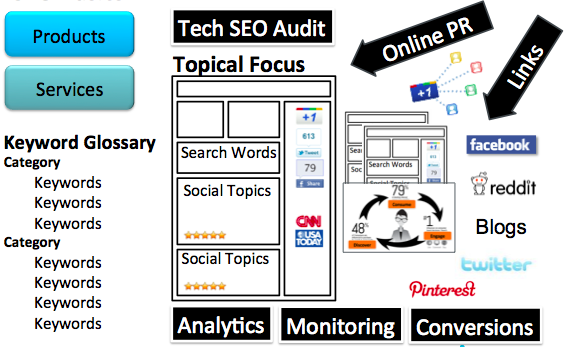 Search Engine Optimization has been around for at least 15 years and has undergone many changes as search technologies and consumer behaviors evolve. At the same time, Content Marketing has captured the attention of companies and consultants in many industries as one of the latest areas of focus for better digital marketing performance.
Search Engine Optimization has been around for at least 15 years and has undergone many changes as search technologies and consumer behaviors evolve. At the same time, Content Marketing has captured the attention of companies and consultants in many industries as one of the latest areas of focus for better digital marketing performance.
As a practitioner of SEO and Content Marketing for many years, it’s interesting to see SEOs work to get their arms around building more content focused search marketing strategies. At the same time, content marketers are evolving their skills at SEO to attract qualified traffic to all the great content being created.
While there’s a lot of great advice for content marketers about SEO, there’s still a lot of opportunity. I thought as prep for my presentation at SES Toronto today, to share what I think represents the minimum SEO steps (9 of them in fact) content marketers should master in their journey towards online marketing nirvana.

There is an assumption here for content marketers that homework on defining customer segments, preferences, pain points and goals has been completed along with a mapping of those needs to the products and servies mix. Basically answering the question “Why?”.
1. What’s the story? Products and services content often includes features and benefits but it’s also important to think about the “story”. What makes the product unique? What key problems does it solve? What would lead a customer to this product and how does it help them achieve a particular goal? There’s a story to every product, because facts might tell but stories sell. Find the story and deconstruct it to the key concepts.
2. Define Topics and Keywords. The essence of a product’s value can be translated into topics that are further synthesized into search keywords and social topics. Build out a keyword glossary using these topics so there is a reference document for content producers. Empathize with the language prospects might use to search or seek on the social web relevant to the product. Keyword research tools like the free Google AdWords Keyword Tool can help make suggestions and provide information about popularity and competitiveness.
3. Optimized Content. Ideally, the editorial plan will identify a path from awareness to purchase and suggest specific content types designed to guide the prospect on their journey. Optimizing content for discovery through search or social networks can expedite connections between brand solutions and people actively looking.
Compare the keyword research with existing content to discover whether the current site has new optimization opportunities. This might be reworking on-page copy to use target keywords, optimization of digital assets such as images, video, MS Office docs and PDFs. It might also extend beyond marketing content to public relations customer service and other areas of the business publishing content online. Search keywords will help improve relevance for search engines and social topics should inspire social sharing.
The takeaway for on-page content optimization and SEO copywriting is to focus on optimizing for people, for customers first. Content that does not inform, persuade or inspire is worthless.
4. Audit. Search engines make copies of content on the web and if that process is inefficient or difficult for the search engine, it can cause problems with search visibility. A technical SEO audit provides an assessment of a website to improve crawling and indexing. Validation and sitemap participation with Google/Bing Webmaster Tools can provide some ongoing insight as to how search engines are interacting with a website, revealing further technical SEO opportunities.
There are many other audits that I outline in Optimize, but the tech SEO audit is the basis for much of SEO consulting that will continue regardless of future algorithm changes or new quality-focused processes like Panda and Penguin.
5. Content Plan. Most companies are not publishing content that represents the needs of their target customers, especially when it comes to search and social media topics. Creating new, thoughtful content that has a purpose for guiding the customer through the sales cycle is Content Marketing 101 – but often executed a bit differently in the world of SEO. Quality and purpose are far more important for new content creation than simply adding a few hundred more web pages, images and video to a site in order to increase it’s search engine footprint.
The creation of new content, whether it’s web pages, videos, infographics, tweets, blog posts or podcasts, should support the need for keyword and topic representation but especially any information needs prospects have on their journey through the buying cycle.
6. Go & Grow Social. Building out channels of distribution for great content is essential for growing visibility. Social networks are ideal for this so it’s important to identify networks that are relevant for customers and those who influence them. Growing social networks through smart participation and being valuable is essential.
Content shared within social channels can be optimized for social search and of course, any public content can become an asset for discovery through Google.com or Bing.com. Additionally, links to content shared within social channels can deliver interested visitors directly to your content and be an extremely useful signal for search engines.
7. Link Building. Besides social links, attracting links from other sites to your content continues to be an important signal for delivering visitors and as a search engine ranking signal. Don’t buy links, earn them! Smart research into the link profiles of web pages already performing well can reveal new linking opportunities for your content as well.
8. Publicity. Online media, whether it’s blogs or the websites of mainstream publications, continue to have influence over readers and as signals for search engines. Engage in outbound media relations to get byline articles placed in online publications read by customers in your industry. Guest blog posts are no different. Be a useful resource to reporters and journalists so that they think of you first when doing a story relevant to your business. Of course, make sure your news content is optimized so they can find it when doing online research. Always ask journalists to publish a link to your website – those links are like gold if you can get them.
9. Set Goals and Measure Them. What makes content marketing so valuable is that it seeks to understand the needs of a target audience in order to achieve a certain brand objective. With goals, analytics are essential as is monitoring of progress towards those goals. Setting up the proper reports within web analytics can provide performance data for your content as well as opportunities for further optimization. Social media monitoring and other SEO-centric measurement can track progress and reveal further optimization opportunities.
To make the most out of the traffic that does visit your great content, get up to speed on conversion optimization to ensure a great user experience and business outcomes according to your mutual goals with customers.
Clearly, this is a topic worth several books but I thought it might be worth visiting from a basic perspective so content marketers can see a path to follow for getting up to speed on SEO basics. Master these and you’ll be well on your way towards having a good baseline for what’s to come in the search, social media and content marketing optimization world in the months and year to come.


